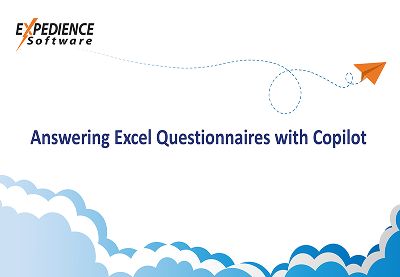.ranscript
Hi everyone,
Welcome to Let’s Talk Business Proposals. I’m Jason. Today I want to focus on prompts, specifically generative AI prompts when you’re using tools like Copilot or ChatGPT. From the business proposal perspective, prompts are the number one challenge with scaling the use of these tools across multiple people. One person writes great prompts, one writes less effective prompts, and right now the tools don’t make it easy to centralize prompts in a way that they’re quickly accessed.
I’m going to show you how we’ve approached that problem here at Expedience, specifically for users of Copilot. It could be used for other tools as well, but the tool I’m showing you today lives inside of Microsoft Word and is designed specifically for Copilot users to quickly be able to stack great prompts within a Copilot chat to get great results. Let me show you how it works. Let me start with a quick demonstration of Copilot and how it allows me to access prompts.
If I come to this plus sign, choose the option view prompts, you’ll see it allows us to access pre-written prompts, either prompts that are written by Microsoft here, or prompts that I’ve stored for myself. I can even access prompts that were created by other individuals. The way Microsoft stores these prompts in Copilot is quite limited though. They’re clunky, they’re unorganized, and it’s impossible to effectively share them across your team.
So let me share with you how Expedience approaches that problem with our prompt library tool. The prompt library tool sits directly on the quick access toolbar here in Microsoft Word and allows us to store prompts that have been categorized in a way that makes sense to you or to your users. In this case, I’m following a prompt engineering methodology that follows the acronym CRAFT, where we might have prompts around the context, the role that we’d like the AI agent to play, specific actions we’d like them to create, what format we want that output to take and the target for those generated prompts. It’s just an example. Yours could be categorized in a way that’s appropriate for you. You’ll see I also have full analysis prompts or agent rewrite prompts, just different examples of ways that you could approach, but the tool is very versatile, allowing me to store and categorize prompts in a way that makes them very easy to understand how to use them. Let me show you some of these examples in practice. So here I’ve opened an RFP that I might have received as a regular Microsoft Word document.
And I want to start analyzing this RFP. Let me show you how I’ve created some prompts that I could use to quickly analyze this RFP. If I come up to this context and choose the company history, you’ll see this prompt defines the background of our organization such that I can ask Copilot to help me analyze the fit of this RFP to the services that we provide. I might even use what Microsoft calls prompt stacking where I can choose a second prompt. In this case, I’m adding the differentiators. You’ll notice that the prompt tool simply copied that pre-written prompt from the configuration tool that we provide for you into the clipboard so I could paste it directly into Copilot. So both of these prompts set a background for Copilot now to help me analyze this incoming RFP. In this case, it’s the background of the company and these are our specific differentiators. So I now can ask it to help me analyze this RFP. I’ll go back to the prompt tool and ask it to help me decide whether we should bid for this work as an example.
So, it’s now copied the bid no bid prompt to the clipboard. I can drop it directly into Copilot and then ask Copilot to do some analysis for me. Pretty cool stuff, right? Just an example, but just really to share with you the idea of a centralized prompt tool right here at my fingertips so that we can create excellent prompts and share them across the organization. Let me show you another example. So here’s another example. In this example, I have a piece of content that a subject expert might’ve created for me that I want to use Copilot to help me reinterpret to align with our corporate voice. So my SME rewrite prompt is going to help me take content that was provided by another individual in my organization that I might need to align with our corporate voice. In this case, my prompt, I’ve asked it to help define things like acronyms or other things that are too technical to make them more consumable to a broader group. I’ll simply select the piece of content and I will drop the prompt directly from the Expedience prompt tool.
And you’ll see it helps me now reimagine that content with those parameters. So that’s it. It’s just a tool that allows you to create a nice structure to centralize and share prompts across a wide group of individuals. What do you think? Not that complicated, right? Kind of by design. Just a really easy way of centralizing prompts that could be scaled across your team as you want to increase the use and the scale of Copilot across your organization. Hope this is helpful and happy to chat again about AI and other cool tools in the future. Talk soon.






